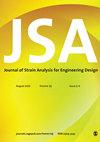测量复杂结构多轴载荷的应变片布置优化方法
IF 1.4
4区 工程技术
Q3 ENGINEERING, MECHANICAL
Journal of Strain Analysis for Engineering Design
Pub Date : 2021-12-03
DOI:10.1177/03093247211063088
引用次数: 0
摘要
在某些方面,使用应变计来测量载荷与使用应变计来确定应力类似,但需要采用不同的方法。在载荷测量中,有必要编制一套适当选择的应变片配置,这些应变片可用于测量通常非常复杂的结构载荷。针对飞行试验台发动机悬置仪表的设计,开发了一套优化设计工具。详细介绍了仪器设计的算法和原理。其基本原理是找到能够尽可能消除由于被测信号中的噪声而产生的测量误差的应变片配置。优化的输入是使用有限元模型分析的结构对外加荷载的应变响应。与使用纯随机方法的常见策略相比,该开发的工具使用基于启发式方法与重复确定性局部优化相结合的混合方法。优化的重点是将简单的单轴应变计连接到四分之一桥,将t型玫瑰花结连接到提供温度补偿的半桥。此外,还提出了一种考虑某些应变片失效可能性的方法。因此,该仪器坚固耐用,即使在某些应变片失效的情况下,也可以获得高质量的数据。本文章由计算机程序翻译,如有差异,请以英文原文为准。
Strain gauge placement optimization methodology to measure multiaxial loads of complex structure
The use of a strain gauge to measure loads is, in some respects, similar to its use in determining stress, but a different approach is required. In load measurement, it is necessary to compile a suitably selected configuration of strain gauges, which can be used to measure often very complex loads of the structure. For designing the engine mount instrumentation for the Flying Test Bed, an optimization tool has been developed. The algorithm and the theory behind the instrumentation design are described in detail. The basic principle is to find the strain gauge configuration that eliminates the measurement error due to the noise in the measured signal as much as possible. The input for optimization is the strain response of the structure to the applied loads analyzed using the FE model. In contrast to the common strategy using purely stochastic methods, this developed tool uses a hybrid approach based on a combination of a heuristic approach with repeated deterministic local optimization. The optimization is focused on the connection of a simple uni-axial strain gauge to a quarter-bridge and a T-rosette to a half-bridge that provides temperature compensation. Furthermore, an approach is proposed that takes into account the possibility of failure of some strain gauges. The instrumentation is thus robust and allows to obtain quality data even in the event of failure of some of the strain gauges.
求助全文
通过发布文献求助,成功后即可免费获取论文全文。
去求助
来源期刊

Journal of Strain Analysis for Engineering Design
工程技术-材料科学:表征与测试
CiteScore
3.50
自引率
6.20%
发文量
25
审稿时长
>12 weeks
期刊介绍:
The Journal of Strain Analysis for Engineering Design provides a forum for work relating to the measurement and analysis of strain that is appropriate to engineering design and practice.
"Since launching in 1965, The Journal of Strain Analysis has been a collegiate effort, dedicated to providing exemplary service to our authors. We welcome contributions related to analytical, experimental, and numerical techniques for the analysis and/or measurement of stress and/or strain, or studies of relevant material properties and failure modes. Our international Editorial Board contains experts in all of these fields and is keen to encourage papers on novel techniques and innovative applications." Professor Eann Patterson - University of Liverpool, UK
This journal is a member of the Committee on Publication Ethics (COPE).
 求助内容:
求助内容: 应助结果提醒方式:
应助结果提醒方式:


